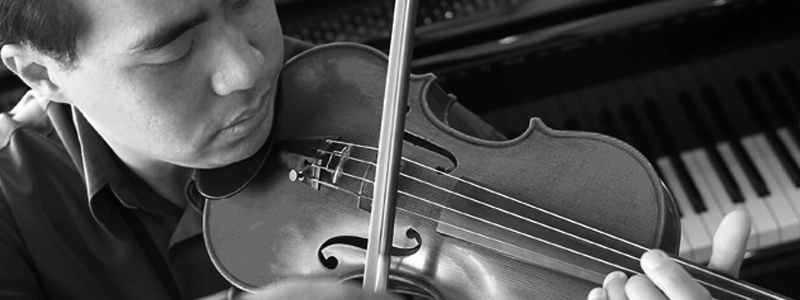I teach using the so-called “traditional” method, which is based on the training advocated in Europe since the 19th century. The emphasis is placed on the technical side of playing the violin, and therefore the goals are proficiency and accuracy. To this end, I use numerous works from the pedagogical repertoire that are geared towards learning the craft of violin performance and were generally written in the 19th century, during the so-called "Romantic" era in music history. I find that this style of music holds the greatest appeal for most students.
Absolute beginners will start playing by rote so that we can concentrate on the position of the instrument and bow. We will then begin to read and write musical notation. We also clap and play the different rhythms that are in the current piece of music. Students with prior experience will be assessed at their audition.
Major/ minor scales and etudes are played by all students as soon as they are able. These help immensely with intonation and fluency of the fingers. They are also a good tool for learning new bowing techniques.
The amount of practice required varies according to the level of playing and the goals of the student. Half an hour per day is usually sufficient for beginners. Young students will usually benefit from frequent shorter sessions of practice (ie: three 10 minute sessions.) Older and more advanced students are usually allowed to decide for themselves how much practice they will do. We will put the emphasis on goals for the week rather than on hours of practice.
Each student will need a violin and bow that are the correct size. There are many stores that rent violins, and these places can help you determine what size is right for you. You will also need some rosin, also supplied by the violin shop, and a clean cloth for wiping the violin after playing. Many students will also need a shoulder rest. These come in many shapes and sizes, and it is best to buy one after playing the violin for a while so you can see what size you need and what is comfortable for you.
Students will be required to purchase books of music. Younger students (aged 4 to 7) will begin with Kurt Sassmannshaus’ Method in four books. Older beginners (8 and up) will start in Paul Herfurth’s classic A Tune A Day, Book 1. Other books will be added as required and as the student progresses. These will include the classic etudes by Kinsey, Wohlfahrt, Mazas, Kreutzer, Dont, Rode, and Paganini, as well as repertoire from the Violin Series albums (2013 Edition) published by Frederick Harris Music. More advanced students should bring whatever music they have to the first lesson and we will decide from there what else is needed.
Student Goals and Expectations
Students are expected to participate in at least one of the following:
- Student recitals ("Soirees") : These are informal performances held every one to two months in my studio. These "soirees" are very useful for preparing students for music festivals, exams, and important competitions.
- Festivals: Edmonton is known as the "Festival Capital of the West" and each year hosts two well-known music festivals. The Fall Music Festival is sponsored by the Alberta College Conservatory of Music and is held over four days in mid-November. The Edmonton Kiwanis Music Festival is Canada's oldest; it is held every spring from late April to early May. Both festivals offer opportunities for students to perform and compete for prizes and scholarships ranging from $50 to $1500.
- Royal Conservatory of Music (RCM) examinations: The core of my teaching in recent years is preparing students for examinations administered by the Royal Conservatory of Music in Toronto. Founded in 1886, it is the oldest musical institution in Canada and one of the most respected in the world. Players of all ages and levels can apply to be examined during one of three annual sessions (January, June, or August). I have found that an RCM exam is the ideal way to give the lessons a sense of purpose. Students prepare a set of pieces, etudes, and scales as prescribed by the RCM syllabus. As well, musicianship and sight-reading skills are tested for each level. An exam is the best way to "wrap up" a year of learning.
- Canadian Music Competition (CMC): For the ambitious student between the ages of 7 and 25, the Canadian Music Competition offers a serious test of a performer's skill and musicianship. Organized in two qualifying levels (local and provincial) that culminate in a national level competition for each age category, the student must perform a variety of pieces in different styles at a sufficiently high caliber in order to achieve national finalist status. This is a distinction worthy for the most serious-minded and skilled student.
If you have specific questions about the violin and lessons that aren't answered here, please don't hesitate to contact me.
